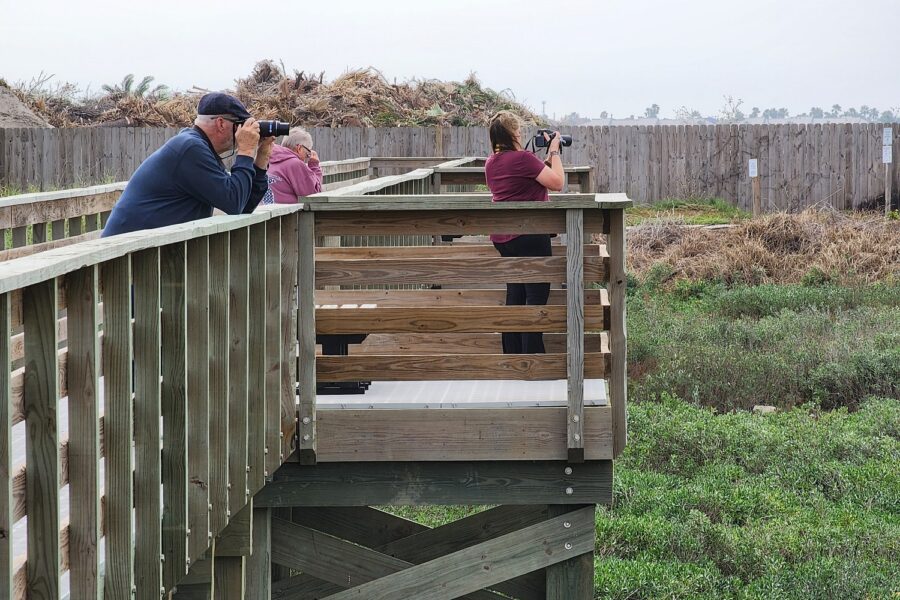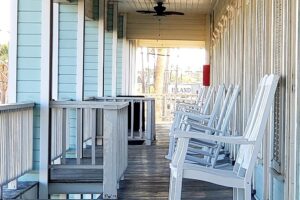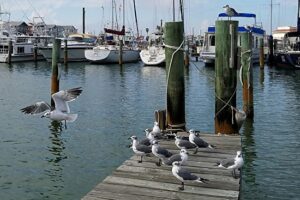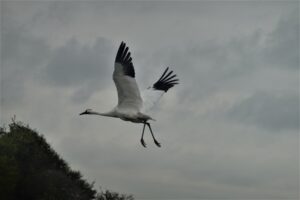A Birding Adventure at the Leonabelle Turnbull Birding Center
I stand in the middle of one of the two long boardwalks at the Leonabelle Turnbull Birding Center, and I’m disappointed.
“Michael, there aren’t as many birds as last year? What happened? Do you think they’re still making the journey south?”



Slowly, they come. In droves—they come. We were just too early today. Michael just looks at me as we both stand there and watch.



We find a place to perch and stay awhile. This area of the Port Aransas Nature Preserve is where the migrating water fowl that winter in Port A spend their days—eating. Napping. Just hanging out—within feet of an ever watchful gator, Boots, at the Leonabelle Turnbull Birding Center. As in all of life, things change—even here. At the end of November, the bird population still isn’t half as large as it was at the end of December last year. Maybe they are still flying south.



The Black Necked Stilt
Leonabelle Turnbull Birding Center
But the winged water fowl that still call this place their winter home fascinate and charm. I love the tiny black-necked stilts. They stand before me, balancing their weight on one leg, with their head buried in their feathers. I think they must be cold and need to get warm.



Michael corrects me and says, “They’re sleeping.”
“But why on only one leg?”
“You have the phone,” he reminds me.
In layman’s terms it is to stay warm; I get that. Google is more eloquent.
The White Pelican
Leonabelle Turnbull Birding Center



We watch a white pelican make a graceful landing, and I notice their black-tipped wings—the same as the Whooping Crane. Of course, I ask Michael why.
He looks at my phone. I Google. There is a long explanation about heat and currents and more efficient flying, which I think is a good thing for our feathered friends that have to fly thousands of miles each year. A website called PHYS.ORG is very specific; I should have known by the name of the website that they might talk a wee bit over my head.
The (Snowy?) White Egret
Leonabelle Turnbull Birding Center
An egret stalks its prey—and we stalk the egret. This egret isn’t patient—he is on the move. It seems that if one hunting ground does not prove fruitful, he is not against further exploration. We see the egret through the sea-green marsh vegetation further down the walkway, and we move toward him. When finally we reach the portion of the preserve where our egret stands—a solitary elegant white statue against a sea of green and blue, I notice that he is stationed at the point of a natural arrow-shaped pond. It looks as if Mother Nature gave him a sign saying, “This is the place. Fish here.”





Eventually, we turn, wandering back the way we came.
A Tricolor Heron Stalks Its Prey
Leonabelle Turnbull Birding Center
A beautiful small blue heron captures our attention. Landing in front of us he begins his hunt. I am fascinated by his movements. I finally know what stealthy really means. The heron carefully places his feet among the reeds and bracken and black water marsh and slowly stalks. Observes. Succeeds. We watch for a long while, hating to say goodbye.





Charlie’s Pasture
Port Aransas Nature Preserve
Back in the car, we head to Charlie’s Pasture near the Intracoastal—the scene of last year’s glorious sunset and our impromptu picnic with the seagulls. Today there is no sunset. No seabirds. No people. Only us, and serenity that stretches out forever and beyond.
















Leave a Reply
Your email is safe with us.